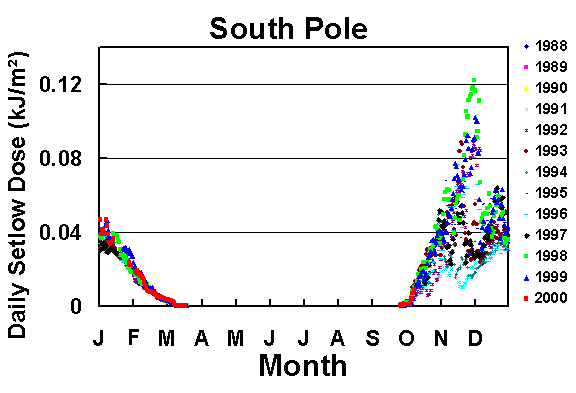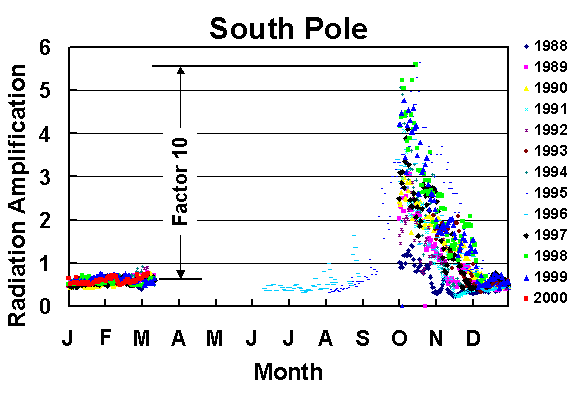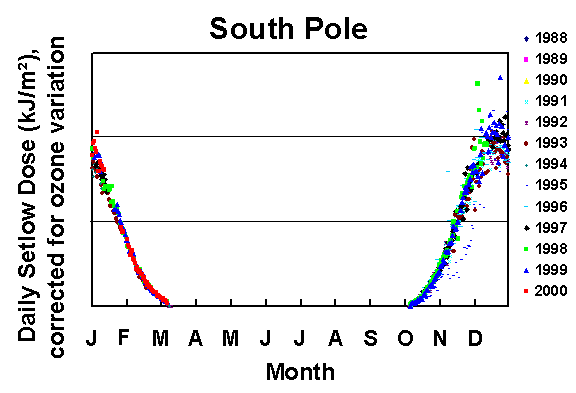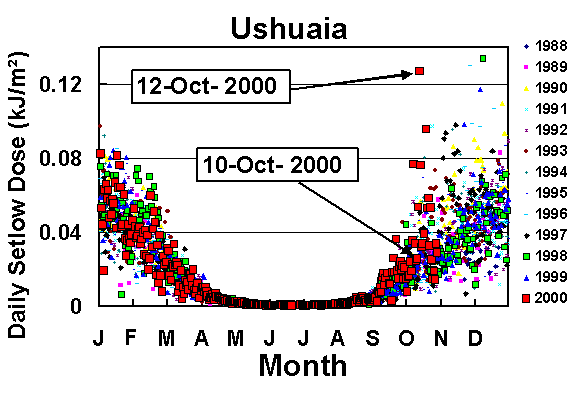This is demonstrated with Figures 1-3. Figure 1 shows the annual cycle of the daily "Setlow"-dose as measured by the NSF UV Network instrument at the South Pole. Figure 2 shows the Radiation Amplification (RA) calculated from TOMS and TOVS ozone values by applying the RAF value 2.25. The amplification is referenced to a ozone column of 220 DU; days with 220 DU result in RA=1, days with ozone < 220 DU lead to RA > 1. As can be seen, RA values vary by a factor of 10 between March and October, i.e. variation in ozone leads to a 10-fold increase in UV between these two months. Figure 3 finally shows the quotient of daily "Setlow"-dose and RA. The ozone-related spike seen in Figure 1 is almost completely removed in Figure 3, indicating that the RAF formalism can well explain the variability seen in the UV measurements. Remaining fluctuations are likely caused by ozone variations during the day (which cannot be resolved by TOMS), and cloud influence. Similar plots have been prepared for all sites and can be found on our website. They show that ozone and cloud influence vary largely from site to site.

Figure 1: Daily "Setlow"-dose as measured by the NSF UV spectroradiometer at the South Pole.

Figure 2: Radiation Amplification (RA) calculated with TOMS and TOVS ozone data for "Setlow"-weighting. Days with 220 DU result in RA=1. A Radiation Amplification of 2 on a given day means that "Setlow"-weighted UV is expected to be higher by a factor of two because of the deviation in column ozone on that day from 220 DU.

Figure 3: Measured "Setlow"-dose divided by the Radiation Amplification of Figure 2. The shape of the curve is smoother than in Figure 1, indicating that most of the variation in UV can be explained by ozone variability.
The largest daily UV doses measured at South Pole occurred on 30-Nov-1998 (see Figure 1). They were caused by low ozone values and the comparatively high solar elevation prevailing during this part of the year. Similar conditions were observed at Palmer on 7-Dec-1998 and one day later at Ushuaia. TOMS ozone maps confirm that the comparatively low ozone values observed on these days occurred when the vortex became unstable and ozone depleted air masses moved toward South America. This indicates that the influence of the ozone hole on populated regions is most severe when the vortex becomes unstable late in the year rather than when the largest ozone depletion occurs. An exception is September and October 2000, when the edge of the record-size ozone hole moved several times over Ushuaia. High UV doses were consequently observed on 12-Oct-2000, which were comparable to the record value measured on 8-Dec-1998 (Figure 4). Between 10-Oct-2000 and 12-Oct-2000 the daily CIE and "Setlow" doses increased by a factor of 2.5 and 5, respectively. This demonstrates that record UV levels may now also occur over populated regions early in the year because of the increase in the spatial extent of the ozone hole that has been observed during the last years.

Figure 4: Daily "Setlow" dose at Ushuaia. The high value on 12-Oct-2000 occurred when the edge of the ozone hole moved over Ushuaia.
Acknowledgements:
The United States National Science FoundationÕs Polar Programs UV Monitoring Network was established under the guidance of P. Wilkniss, former Director of the Office of Polar Programs. The network is operated and maintained by Biospherical Instruments under a contract from the NSF Office of Polar Programs (Dr. Polly Penhale) via Raytheon Polar Services Company. TOMS (Total Ozone Mapping Spectrometer) data used here were made available by NASA/GSFC, see toms.gsfc.nasa.gov. TOVS (TIROS-N Operational Vertical Sounder) are a courtesy of NESDIS Satellite Research Laboratory, NOAA, and were kindly made available to us by A. C. Neuendorffer.
References:
Booth, C.R., and S. Madronich, "Radiation amplification factors: improved formulation accounts for large increases in ultraviolet radiation associated with Antarctic ozone depletion", Antarctic Research Series, edited by C.S. Weiler and P.A. Penhale, 62, 39-42, 1993.
Mayer B., A. Kylling, and G. Seckmeyer, "Systematic long-term comparison of spectral UV measurements and UVSPEC modeling results," J. Geophys. Res., 102, D7, 8755-8767, 1997.
McKinley, A.F. and B.L. Diffey, "A reference action spectrum for ultraviolet induced erythema in human skin," CIE Research Note, 6, No. 1, 1987.
Setlow, B., "The wavelength in sunlight effective in producing skin cancer: a theoretical analysis," Proc. Nat. Acad. Sci., 1, No. 9, pp. 3363-3366, 1974.
Back to
| Session 1 : Stratospheric Processes and their Role in Climate | Session 2 : Stratospheric Indicators of Climate Change |
| Session 3 : Modelling and Diagnosis of Stratospheric Effects on Climate | Session 4 : UV Observations and Modelling |
| AuthorData | |
| Home Page | |